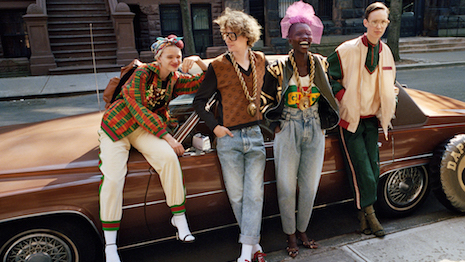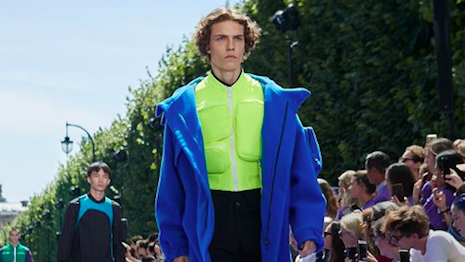Young luxury consumers are more interested in quality goods that are unique, artistic and reflect their values according to new research from Highsnobiety.
The first white paper from the online publication explores the priorities of the “new luxury” consumer that its audience reflects.
“For us, the message is clear: consumer relationships with brands are no longer purely transactional,” said Jian Deleon, editorial director at Highsnobiety, New York. “They’re not just buying things, they’re buying into value systems, lifestyles and products that help them define themselves.”
Highsnobiety surveyed 4,984 16-34 year old users from around the world and assembled a comparison panel of 2,379 people in the same age group in the United States and United Kingdom. The majority of respondents, 73 percent, were male.
Value demands
Highsnobiety readers consider high-end purchases as reflections of their value systems.
Eighty-five percent of respondents believe what their clothes represent is as important as the quality and design. More than a third of those surveyed have also purchased clothing, footwear or accessories that cost $500 and upwards in the last 12 months.

Gucci-Dapper Dan put a branded touch on Dapper Dan's eclectic style. Image courtesy of Gucci
Among the most desirable brands for these young luxury consumers are Balenciaga, Gucci, Louis Vuitton, Calvin Klein and Prada, many of which have embraced streetwear.
Louis Vuitton's fall/winter 2017 campaign included a streetwear-inspired aesthetic and hip-hop-tinged short film. The clothes themselves were clearly modeled after the growing popularity of streetwear, with sneakers, caps and a monochromatic color scheme anchoring the collection (see story).
Brands focused on logo revivals are also popular among men, with Gucci seeing an increase of 21 percent in men's consignment resale value according to The RealReal. Millennial men also consign and buy Gucci and Louis Vuitton regularly, with Rolex being the most purchased brand (see story).
Two-thirds of respondents also believe apparel and accessories can demonstrate whether or not the wearer is “culturally knowledgeable.”
Highsnobiety readers are also more willing to spend more money on items that are special in some way, whether a limited-edition, 37 percent, or an undiscovered brand, 26 percent. Forty-two percent also say their favorite brands “inspire them to expand their cultural horizons.”
Young luxury consumers have a tendency to look at expensive purchases as a means of buying into a lifestyle.
Fashion events, such as exclusive product drops, are popular among this group because of the opportunities to meet like-minded people and share experiences on social media. More than half of Highsnobiety readers have attended fashion events.
As result, participation and ownership are being conflated. For instance, souvenir shirts from Virgil Abloh’s first menswear show for Louis Vuitton are resold for hundreds of dollars as consumers want apparel that is culturally significant.

Virgil Abloh's debut menswear show for Louis Vuitton. Image credit: Louis Vuitton
Highsnobiety readers closely follow their favorite designers and creatives, with 82 percent following them on social media and becoming familiar with their creative style.
Younger affluents also value transparency – 87 percent of Highsnobiety readers are willing to spend more money on a brand that supports like-minded causes. The flip side is that 53 percent will also abandon brands they feel contradict their own personal values.
Drawing affluent youth
Heritage luxury brands can appeal to young luxury shoppers through unexpected collaborations. Ninety-six percent of respondents are interested in traditional brands that are willing to go in new directions.
As the sneaker market continues to grow, a number of luxury brands have launched footwear partnerships surrounding the athletic shoe. One of fashion designer Karl Lagerfeld popular brand collaborations was a capsule collection of Vans-branded sneakers, a favorite of skateboarders.
The Karl x Vans capsule was entirely in black-and-white, two signature looks that the brands share, and included Vans classics redesigned in quilted leather and platform sneakers. The collection was sold at Karl Lagerfeld boutiques, select Vans stores and on the online sites of both brands (see story).
While young affluents tend to spend more money on luxury apparel online than in physical stores, they still value experiencing a brand in real-life and sharing that experience with friends.
Digital media cannot replace the sensory and social experiences that come with shopping at physical stores. Despite the growing popularity of ecommerce, weekly bricks-and-mortar shoppers have actually increased, from 40 percent in 2015 to 44 percent in 2018.
Retailers can leverage positive shopping experiences to encourage customers to leave feedback in exchange for further discounts or other customized benefits. Integrating technology at physical stores, making them “phygital,” is crucial if retailers want to follow customers’ digital footprints (see story).
“Street culture and the brands born from it are so much more than limited-edition products, the drop model and graphic-driven sportswear,” Mr. Deleon said. “The ‘culture’ aspect of it is equally important – if not more important – than the business model or material goods.
“We’re talking about a movement that has lasted over 20 years, and that wouldn’t happen if there wasn’t a foundational legacy that should be respected.”
{"ct":"qjLbtiJsIRSi06ZFI0grlTUxG0UAZQiXPWiKegYxeTQEEw0aIVYPJlM0JaUhjReOnbcZcY7ayRPhGo6sUTPugzIluqopHQLiu0Kv2BYI0S\/shYRhyHlk1ErWWoOnWHyrHT9aviJPi0SULRcFsAEn8HbosRTHt3NKkHBx2+6UxA613fNrbcej0\/J8DZHCRKeebYI\/mR2T50nbz8svdUlq3f9bsqIvoYBH8SPON0oMFUm31G569xdDZo9UBG+fUHtBU79pVUOllr+Xzce1q9S2FILEyGDnLE5JEjllD6NW9m4EXeuAzNUR7SCWvLqyRnUUzW2HCjmagON0kHIzPLCZcTzi2YuK5rupMQTdrkHdxhuXO1WwNK\/uFT0Xrg\/Onn91jcVWjjzOtrMfK2t+Lr3c2Hr1EA4XerCxTC8dKpQpnEzEOqNypYA9+c5f0snvfOr4evhxLdpKXZiAaMb96yoh7j2acOfGPsSp3+sxpROf6IusBL2s5tvej85ZWc91Y\/OTGwYeJ6Hk5HpjDUGAUlp1ABdrMTQflQ4I8DKr\/jJqc2yHnhxpUk1oBOtWxnRFzqqRH9uBritQt1lymSuXowOH7zR4CE9dFrJsnGaIYfzdgWequRj2yCOmrSe\/y1d\/p8QAyK8uwCFZ8THYS17WrhIwH5JKy8wxmIN6p5zzhh24rH7CqnY9UOCT6U3JWMWgideVq8LxvocMYuJ4MbwWI7A0UT7R1EyTom\/87wAMTM+SDBDijrmBzmoYfBQTxnbQktBT3XctgID9DkPNJt\/dTOJaaAZRae4ucz5Q7VYb0HBaCeNbsGRsFrN4ywUaRa5mjR\/LWnTprks5jLmdiNUSVhbvqT1iDUb5kzfrVRaquTNyppyXNFQHkB8iDD4\/Vb80kqXPElj+apANaSJkE7nLy8By3PXEq+62UIw\/ir2JU9tfVJXNHW\/EfazuTiHr75X6razMiQiHTNTOg5E+BuRz976uLS2d7j9kmxnvytzG34mbOdMCtat8HgH\/Lht4ESyxexIF\/rqyunYvhshBpZuzOmvGeZU9vGOzIuhfWzx1Inb7fKRY23Q6\/8+NBWCUeedpwPBapEDyiVqwP+qRokZGoq9Fmw1944jTSycJyV6kyseXQuEqm7P0VltP7g3noSXdXesRKl\/ABYDtPCeRwy7\/xiNOKxf1iCclS7JPNRSnRydP6vUoLUizPQXM56QjoUKHtTioUOXkyC\/vM\/Fpp+JFJWu5TtlXemofx1DYoqZ+2AlPaZ4Y1swihgunUF9COjzcehwA0SXdBKZXok7ytQJQ81zj3Zno+gEsPc8BJglVZ3VWi0i3UEj0ozelZwnwyeO9q9H4g9rTRAosOc1lroY\/Uyc6T\/fXes2lZqS52eXSUtS+kGyvT2Og6tOxW48gWzRcio+F\/950wD0UlzaS98Ils2E4TwaSnP1qvsnZQSFkYwLJtsFklbypSVRAo7dmT9zwr0zYmw1s5c\/cJHXjVQd7NUoXoY5jgZX4yA9p4+58hIXEnqIfyB8jEKbrTlxH3yEAOO\/Zc9XvJCq\/OoEj9uZLGfTEoJxLanGysQlJWJFPqQ5aUr23HFgzfMfgN0PZlPkLqiAC1Qo3yuO592sHG8vqJFNCn7p6ZZYJa6K8P8gr4pHcbwiG+GLvMHBNhijEZvNQ6nxrftkG218x1NlSKdJNrNCe5e93sbNMQlVdMNf8CVe\/1CIiSN8wYiUuorpvyNUxw3hw\/+BAOOzrGQfYIobTdtVetI5DqZNtTAO9T\/taqIjZdeQnZIu18MAwspMqCyqJqXlkLTSvhkNn3OJhcyPcPn2Zmy5EF\/4cGxfFKOQjWSrEOpqXjgSaSWZoP3uRpv0g9P6GJD+lEEeB41GeoOvuO40rIoSJs1FLaLkb+MqYhFlJ3OGK3CiGU3zKruoN95NXQ1LD0eGzIcD3ZW6Supm7qajSTBHfHBVTOkNv0mJ1q492pCHfow7Dx1YrT+YqHQgelyDnx8JSD6j0pNxd85J8Xpqu+OgQ6GSm0OdQq1B9xoInB40r\/4GKnWbbAQ\/3M6d9sCFhBMOY8ZyEtkpwUE6NujU8wE42AJK9BaxWL8tvqhrq5g6HWMWJNoiNfKfBe6HwaADMXBQkj0l\/Ps\/mbwQK35Vra1Q3KZdBZqQ4jEqWmeS0Zk2TfkqHKOWPCTRYXSGlcuzIebS0AIjQJhEojsSLypvJw2zDH5UsrZ5oukZ6AP5v6fEuK7QlQzVAUWlnLJ2\/u77upRG7zHT+JE5dgbUE2H6zwFNS7fDf8RFnIPSFrpBGS4moq61J4J0nVO2sDQxKt5Bfrx+QM8+gr2RNdrjAFJhfCUcK6gZHy8bukoXJVYBkqBYCBDks+snye0UWcABEusGYCEhvhN+vXoZ4tPfmeG8Si6e48OwKiaDfO+B5bAMecn0kIJpx+SwHUKGeMLR1ZJSN6jjH8r3gnn5tC98qBH\/3\/1\/tYl3WApb2\/Tug9kZh3aEYpPN+LpjGkijcqWUyRpkV6TKrvNHDg5dP0yXuPoF26kGfhmSfAV7WOtPhcJDaB1WnTdJULTQBXGjadQLU\/pVlW\/QGx6638mu8uunA+zDKbszuxuYyTN3Kl\/pI7qT8gRbHK\/KDwUMg3GDBFLqNjVZJ3s8XesmfwSV2OtwwkM\/DkbpYj2tKWQhNrr+28S6J8icOHfVx2JpbrPr+eQE2BLs6XOhu+OvhEREE9LbcAcDG+lBQHLNIWoij46NnzbjgBjv2I9hejySJe1x\/DCLrIcpE306nGNKxRuYg++u7NZiayfGfzmqRUsBf1kyoYEBJ9TdMtf8jINHBdyBs7mlBEntEK\/fMaJyDVslOFRS9yenBWEICUpFzA8tgntZMups8BbKrvu6ocuwgFNWEvDru\/c0z\/384jeGzDVGzyxKyMFgewgyRwwXR106JE6r8RNWITWO4LclmjjF9CZD0cn506CunR58nP09sThXAWQMkKn5UcS1Uu+ktYTlTqxWI9G6nHjDpfzn1o50Ua4D7L0TTQfs+BjgvVgpfFr0fbz4vUnp\/LPIbgUUS3KvQqEk6mFwYvAJ9U9u1DV1aorY7g1uBoT4xrOqRLmUOjYLl2QAAL91j+gmC1TcvM5U6Ea1A9\/d2v5gX+1q9sWm\/ltvmy3sgelpPbN11VVCca11a7gNYJqx7C0cYscSSPwy198KInARYaTWljdiFzprCHdMt8egZLLqgslcoCHU6wqUk8I8Ceo8tCtph\/R6j6oqWBAzZQTpM+\/yqK6gCx7pbnOkJbcTwbKXJF7Wk2X2\/Sd3gxykTkjEILOClqRAMnXyYj1vFyfTWbduY2g9MrytlWDUPGql6V5AxnLoVv4eGQqx+TinV8uOtdyCObUFwecya+ptEtMcx4fHqimaxpNt0Q+DIlCjy04ZlN4ft6mtDJW+3PQupFFXXpeiID+x5RkwqC+23X8sOq6WSQrKgN4SPkG7u5k\/CP3eHaCmyGfstMJBih21tE1E5RsXZ11pU7nlhVN6QXpkwfs+louQC1PCSHGt9Zzsj7OgQR0oTDStR2fey89fP4O9Z0SdwZHlYWi4fvhMJCTeTW6qMHdM6FyerIQ5MRMEwHjCy5PzpJQFzS8J4VV3WGwhEw46zCpAo51VJ81AL78lxb+mSoSMwLMYSQHsXEFe0V3pJnids7QeEr+qynNYD2Az+0i91Zek4bSGM32xovLSnt46T\/wJ3ORF0L7TtmErU2k\/OVSLyXOqdpmUgC5+IiQ\/HU9CaKCI5lJA0aGZbkcVN2CkDQ59GJ6CXEjdR8aPhSAKouAsAbXkcnjU8uJxa15zy8e2VwIh8KtVJ9sSYsBbwqwSu8Jp5pKqMVM4clxQ5lVdln5leAYH5qah7QQwKaoEtPV6\/T\/9AjzWf4to9lutdo+1YvrqC4FXPcMIPsBZv5TsAzhnmBLiDA+Wjyfi2PGzDfoMg1TwIj5DB4kFAppt11y05hKXEiBEzGPVyoExrCffF68kB2MDnAaqtXBpdVtilnPe4jRiZWQXiW7DeCGXtf9P\/Scwg57yxkYylPoETLO87pSWj3xqznMx+iNh7VtmdIvvgokBpeubVJcxrWRz4jDTkXGKPlwnV647CPUbT5Z6lkxYxcYRllC6crOhWFmRTa++ZUPVJg5cirUMPJ6jwg3rkhjXNu3prCpWvmbOf9NhmEHKqReq8dwRW\/z\/oPV7iUdJauMZEB97\/E6A3gnhIoIC2jBcEhbNWvFw1MVE27ireK6EmGCbJPLvQ\/VPYFfYiunCYYwYdBMZxaubnBla1Xg\/5hpH+gXRatdUs7+w9JuLb62sN8gK7fbXOP21eo86DC8wHLBj7E9J8FpY3z6cCBswX5tMUhv0Ka0ZDqu4fmgXApKceMWrIWpmaKf+Fz77b3voHUl9zKkX58Bh4Hp3J\/uXlyomYlMk+7G64Sq0wl3KZUqa3fVzeblAGLut\/\/amhe5bv3ywEMl3Th\/7iKTSNgraoyJkoepM2C0y\/pII2blK\/6ejsBvUms7U0JbQ1JZGlxgBB5FY7meULYWf3gKlk1PK9iO+ki09vWXVn3hfXvEIiSjMHnFeO+AhcuVrN5IX7o3tU0OGY73saYPZs1Yqj\/cuuPWYZaHxukcwmqaEgZQ5W2cOtcjrmGY6P9gVD1SHWvjcgW4BGsjISSNqviq9RmXlH6mHHxCA8ykhAUJpZyIJZDWrxvO2ZXNzFrj1qh1tfhi+IbdPT89GKpz04tPx3QzNOi2\/WlaojBqgmE9Cq1RI7OuZ+l3clrQKAF5RdmZpIFIXxei4ZrNMq9X6e\/6RzGFHE92Cj17OY6lLfuxW6\/rWbvuqQP6FuZ0zMv3VjYFHoA7+9aTwCGeM38gahg2zXsZdR8ALt0Lac7DCg8ktMOyr1qk6yusoaoQf5vGZZgtPxmQIs85vSSxl7oxwFoxlz5o+JvWHGZfz90z9zV0gLpfW+3h++E2dZgL2PvTFCHtvRWBFGCkZuufOJKZNVGjOz7y8mzYPVASYqIuylJvyZIn69bTazRmiZtOVPsTVowqp84nweA8y4xSc4Do1SGnhALaFgxkgNQwn68wmRB41OUC034gOGJ6iOqHiLOZrPZ3XYFchJpoXoqWJ+pr77md8siU1EfniS8XKS4bADrTtV5YEycTZpI62sr0ttexBanmktdHfZBzaBtPv\/oE\/FW5RiLrvRCuSSNDPxV5whG4gj+5ff8uJy7qOQ\/LHg7KvijB1vY4TLkQd29xiKQAfHLbg2Xea7GpLyLchk4p878S9vQTU93sqBWHQja2nU8Z+Knjs6WUzoKSJZ0NqChi51g\/Htvh4mVjgOM2Pothpu5IAKLQsGQVGN2bnILh0NO9cKZG4T+l7NGbdVN+4+bn3ZOguplFzGqYAzEiQ\/2RXJe008CLNowm8cNBhyUAWHZqO49irqQlx3NVPldTNzQxURJWTaHSrDV5kh6xBIWG6yg+L5A4D6T5LVx2yj3vcxKOeqDkpQNKQoMvEzLUMIP5LVZThfi09jVhNuE2CTdymVcMPOQoDl6EFFWcXJ4C0eR9D1kOKV0sOPmIesHeiI7AOW7Rn5nz8K+kJOXA3MfvfhO1aPpxqYFztiA\/mElXfOjU+iXbgb32wGytTYYOyJ8omV55DYfeg1EC3IfrXYIvZbMJKw8trNhbMOceOvmk7t7pNJc+nYGloNAf9TMU4\/i0SRszY+jb\/J9y78iNLZKYOOj3sGbyoU7i96GExaf\/V08KUS9nAxu4JIHqqgq\/\/OnXH1Nz2RBCyXkJ8BNXnWX3lyqQeeONiQMsYnAWTU8EuF+\/k8HYOyDCe6MEuZpjuMSjHROpEx+gR5PhL9ob2BYhJQxwqHTFLvGTUgUSyl+fXBwhNJTN1P4MNSelHpMH1Jk3\/nCNr6+FW6CVbYLIam8UPjk4y08Vfy4\/8YNxnE7uShde3zrrymomyEMgptVQ6X7MMenwLRurGqyh4BQD\/KKI9Mg6VduKxgvLvvyGqJJO5f+SeoXqKBz+BoF4PMcreWIjnFU04ve82Nqa\/knHP\/GMahzIFa7dUWHKrdbuFe1D9+V5ACk3ViYMW5aPwXGVigcFW0a3N+EzM5hlCx8yPasfxsVv3yzq1TRVQwgtp\/ibaoMHBib1rzgmmttsJ4aM36zPckgfs7WLsogxizkpg2BKY+Y2V3baZ4Yzi+vmo81+jCXH9ZmZgK9rvOkd0zepdy8AdqFmxmvkxLqaSuw3Tj+2NntX6lBPBrWMyepHiXOWODX8MplpT8Id8ZjqyrQsw71hAAC0F2T1RdwhH0OsfLW37yYS+uKiogU7S290TTq5+tKialEZ9tJt8twv8kTYyzO7aq77gPVxoo2D\/ewiCEzPKKcgjda6hJhWdcffmf\/LHYnCrd6C9i0oKmkkMQFsUj4UYYYL9TI0tLO4Dn1A\/nA9OYVviAfiouj\/L9Ww1GP143xPzBuOPrena4hfsNmITUAAAZ7W9TiEGOcno5DO3l3lSaiPOK9jYw21DGOK0mkf8XjUrUFSBMGFo8JNMGJ4buGd0DX5jM7v96yTULMsqhWX1mVyPu9VqItbb2\/bq97esf2V\/YuncrAF6lkXMwvWO3Ykn8CuJ9Mzr8C06fotLODug2pOfkU7Hhzp\/O7ebxiCXKnWGdeQINTrd2xC2iifpCJpW7xEfWkKD\/LImfltpHYjsQ2xmQRDQ0DxvZQs3VhxbWbJDp5V9fCo7KWUWnDqG9eB5xC3MP5RTlySsdTy9K782ZxMMT3TdbHkWFqV3zbu+ygzSqpX496cnvPu9GuoJy8paapWZS3+9+jBLlM7UCS8xxG4AKHl+142V2UvdehKYnFeCSVUzIz9C2lXNqIr3TahyZVDsfefmxNqctKej+sEIja\/tKv\/4dvEXfzxGSgY6GCkC0f2ZMqFQg2BfxFgT7ECAhcvXJVPY6ksPP3pVtoRABJ9wPNIlyYWVzgCHGstEtr+MKY6X+w006BSiEz7x3wWrkOX9Zfs1knUi01GslIuHffz4UxDZ3OG0zimE6ikaUIeqf2bcXY2o4GcXfnsi8a0QDOO69oi\/VTL+aD3Ib54SMS+o\/ht4v+Zgp1SrFHFgyrv4DaQTMdDTAoOm5Ai5x0W+tMMnc7RDq8CImGZkYYZuS1D\/IdWn3+cHAWu+sDxiFv4ALtNwpIPxHHT6DmvV\/8asSDaSAx3Hzd6QE\/RsAwVeQeH0t8MfjwV4fKdxl2CzYN\/b13GYbVSNN9F7UTGHCtfYAhiDxWRcDS\/ZEPT9zCQLt6OzGItqn8iV2i7FWCa\/NnQfps9ho49F7A1L2jQRPGtSM4vbCq7F2zewEl0Zo2GeU19fl8eWPTzcTwUSONnFtnJ01eoK4pErU3fti1Iu7QJVjpx3pCKOjuLro02DtnXV8PyLu1m9EKsQBmAkF9LrDFBOkp+QZfGUobyaOqmHWenu2A\/XJFlPtQSf1yArxOBt9rv3b4MFMhCxSUBWNsejFDQKisB7ZAdD0Q+veJSzyO\/0K7k4sNg85qRbMrr03TM3YRIi3VbW1HaPYbznTq6MNS1MkVCEzt96H4ti\/cprlNVcWvIDHK\/SsxBkfWgBGP0qUg3Zd2dgvYVKxppS7fNRoY\/gqu9Sade23DO\/9Kxmwlid8m5H0MtPypjuZ6Gr3rXx7Q5zd0SyNkyKReuYU6WqJRKgjDTalgo79Nf5kdlPVEzFMpNwaL3satwUDu1yfusXbApGevVfjpd+8QydVYLRdAuPAFJdKbhmUEs\/X5ekZ\/p+OiEFUVVKSofL9zjGcS5BGkJxapdjYUQbZLKzehoVrv0h4qkGXNBPYazLkwX0onh51p1Sw6b5neCi7GBghRYgrw9s8GLhaF6cObMPi5onEeZCzMoF6bvlDe3G1YrIsjzygs4YHP93lS6MNilJ1gRXGRPHjWrcdbMq4lNKhcIWj3UplnlryGpul6Kr2Nm3RWdPKyxG2LQPNt4YB0BHCy1Jy8+VQUJ9EF8MQnEVh0s6vLLCZKLQCTx9EIsGwMU5TzswwhUctymUSoDsetSFFCK9UP7AgHOni+Hl9xMuGbbz\/0kLyXwOdEJBaOLtZqwCx1AFQle9jL05nquc7JiqIGUj1Ww\/VZS\/s+ni4wH1JNz\/p2aeoYKNZImYbVwf02W9PIWdijGCEI10xwkF6ZUJQALvF4IZJ2i5FV9Qxf3FrnkWcaTLErd5+BtBZdHU25N\/hT9aEmzr0uygFZajS1BSKl25inFc\/QxlmbbUY4HkmYxwx10uQx83+hzglVi5DJJa5fuPzY1Enl2c5JQ14Fltupt1MgFmoC2Dv0zctkuadDrPVlJS\/8waUS1eUdiQtkvmXpw02ff5zN9m0xXGvsutKP+SXlnxkDsqgHeChsz3t7FRCvNIjVXnMc9VC9\/9J387JhicKD8R4rimbUGBdoDDtV20Dp3lKv5\/PfG+z6WEs7DiG\/mzlo9Ri8SIdcx1bNLqgkdlXzqASDyrHsw\/\/E0xuouQnTn+s1wGGFeTxKYCdVqKJMzA64dVf\/O1gBYtKm50Mu255iAIOelPLbSLSz3cXwZyhkQokDht5\/fOIIG+YpoLO+Y2kYrTN7Iin7O8as7By9ARHaplhsGoy5qYx5GY6l1sQCUWHCj0mzMtm6R0Vc0s0WUSBdyuuqTi14BehB7exRx1bzKNg\/HCpfwIqDvQtWDyosDGQ1qQLnBKdOV\/0ADVImQCRz0xQ1tchLWMfw3Qc7cq7HGYPPRgGh2Eo5PlzjYEcBcMow8RDkUXa78pyfM6rrAa7INxq1TVhN3\/68YIjAbbeV7HD+qitMo5FFw+APvw2+V3KZyWQWg7g53s2K6r6PU5uxKecm2yGi7S7jOEtmd32Mase3JM946VYZz6iqrl5y\/PLaSnDJ9sfRakKVcZUDsnSC28p24Klz7gFqmUr5lPuKguAFdKGBQG2K8ku4+PZ98pvB3HeUjQQOaiRBKAy+Om9K4ZKoLplVoWnlnAN6DsCMp1ILoK95zD\/GlX8zW52Ajdg5JlD1koF\/Pxcs8xwbwpvW+uRerT0sqInHadz1nk\/rDRGctHRfZfODW054HS7a8WRyQmWu6TUhsE6w4EP\/u3swNXgqEH1qVh3U\/Fws755iM6lbKi81M1PdfchqSJgj\/JNN074DBTpWtw+UNtn9KalUrUqYOhW4sB4B6iK424tLIWsy2zjjSuVhP9b7Lx2OlVTUtV\/V+218gMC1wnZbcUqzIrzXDz4fZBBlsg13b1ZEQYQSqJVsohuxUFS84phzVyogp\/GC7XwrY62z4eaBlddfBm\/qTBGvKsjZWbe2FUzg7OnCVzVGumGyst+IdG61GhJA5m7fSs6cxMMbFfOBiF2zw6kEu6oJnw0MrJ2cx\/ZFOYIxudzoBG+YHNbmaeI7EBysHs5gmEitM5bFQhi114fJYlIl3GFQuYqT35eAVJrjwHdQuN9NueT+iVCBGdCsUJ5REfD8j\/32QrWjuGFB1abF\/+F\/DO\/6daFZX52y+\/s8eAfDtrmKiwqm9Bsesi+rQeuGwR85lcdCBIKl6p7\/fJimTchO\/X0nlzemrFH4x4VOfhwOtRq9A6+8tivNZhBLAxUYMJUiz3LJvHaJihwdGC\/+X\/tm9a6H0blPwksseIP01ADnTTwwpEjIH19ZfIdzWs\/qJD3eIQcx2Jq8dtCaaYKTWycJwmqC7aK7fQvqSlBrDsur14qpZaaDtdAHr2uKADEhnvCU7+sh8cQ4\/3AGHB4p\/5VEhbtDqULMeELcKZ6tvjh5V0=","iv":"52534153e19e2c687af8265d132bb03f","s":"85e90302e718a2b9"}

 Balenciaga is one of the most in-demand labels among male affluents. Image credit: Balenciaga
Balenciaga is one of the most in-demand labels among male affluents. Image credit: Balenciaga